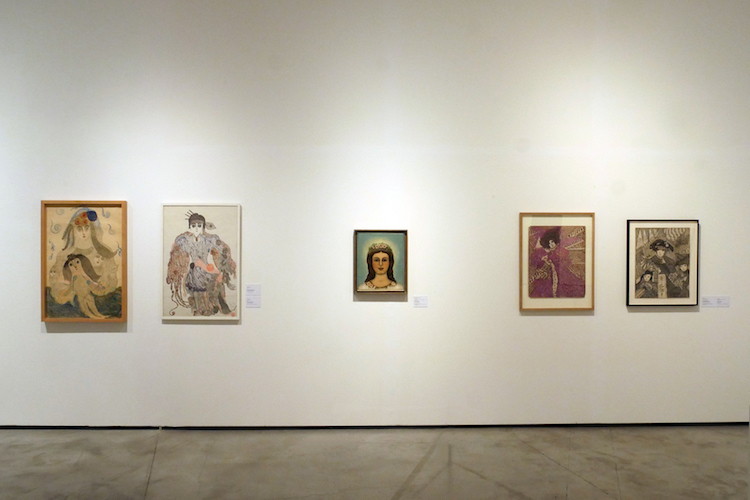Search
To search for an exact match, type the word or phrase you want in quotation marks.
A*DESK has been offering since 2002 contents about criticism and contemporary art. A*DESK has become consolidated thanks to all those who have believed in the project, all those who have followed us, debating, participating and collaborating. Many people have collaborated with A*DESK, and continue to do so. Their efforts, knowledge and belief in the project are what make it grow internationally. At A*DESK we have also generated work for over one hundred professionals in culture, from small collaborations with reviews and classes, to more prolonged and intense collaborations.
At A*DESK we believe in the need for free and universal access to culture and knowledge. We want to carry on being independent, remaining open to more ideas and opinions. If you believe in A*DESK, we need your backing to be able to continue. You can now participate in the project by supporting it. You can choose how much you want to contribute to the project.
You can decide how much you want to bring to the project.

Over the last years, various artistic institutions have been focused on the recovery of the works of artistic women of the first third of the 20th century. Such is the case of Behind the Door, Another Invisible Door, a retrospective exhibition about Dorothea Tanning. A work with an oneiric symbolism in which girls and women live together with open doors and enigmatic spaces and other realities. It has been inaugurated in the Tate Modern Gallery these days, after being in the Museo Reina Sofía. In this context, the Museum of Modern Art of Mexico inaugurated last October Addicted to Remedios Varo. New Legacy 2018, which consisted in the exhibition of 38 pieces of this expatriated Spanish representative of the surrealism. More recently, Jeanne Tripier. Creation and Delirium at La Casa Encendida in Madrid the reviling work of this paradigmatic artist of the Art Brut. To this, we can add Hilma af Klint. A Pioneer of Abstraction which could be seen earlier on at the Museo Picasso Málaga after being inaugurated in Stockholm and in Berlin. Even though she was relegated by the art history, the enigmatic Swedish artist got by without the figurative language long before Kandinsky or Mondrian. She created a forefather pictorial language inspired in extrasensory experiences through the practice of the theosophy and the spiritualism.
In this reinterpretation of the art history and the creation of new genealogies from the feminism and the herstory the exhibition Alma. Mediums and visionaries, inaugurated a few weeks ago at Es Baluard, is organized. Curated by Pilar Bonet, expert in the artist’s work and the Catalan medium Josefa Tolrà, it brings together drawings, paintings, notebooks, publications and textile pieces. Those are carried out by Julia Aguilar, Aloïse Corbaz, Käthe Fischer, Madge Gill, Mary Frances Heaton, Margarethe Held, Gertrude Honzatko-Mediz, Nina Karasek, Emma Kunz, Cecilie Marková, Hélène Reimann, Jane Ruffié, Clara Schuff, Hélène Smith, Josefa Tolrà, Agatha Wojciechowsky y Anna Zemánková.
Oblivious to the official circuits of symbolic and economic recognition, this group of mediums, healers, mystic and visionary women of the first third of the 20thcentury created an autodidactic and amateur art with precarious materials, of the domestic setting, such as the ancestral art of the embroidery. A non-professional art, the aesthetic expression of their extraordinary mystic drive, expressed as well through the automatic writing and the creation of freak imaginary alphabets. Likewise, the exhibition has the projection of documentary material in which, for example, you can watch and listen to an inspiring Joan Brossa narrating his encounter with Josefa Tolrà. Concurrently, the next day of the inauguration took place a cycle of conferences organized by the Creativity in Visionary Woman Research Group which concluded with a dramatized reading, “Fuerza fluídica: Josefa, Julieta, Aloïse y Hélène”, under the care of the actress and dramatist Núria de Calella.
The exhibition, divided in different themes, is sequenced by intriguing blue doors that invite to lean out in different worlds and experiences that go beyond this convention that we call “reality”. In the first series, the spiritualism and the theosophy are combined. The following one shows drawings and paintings about interdimensional and extracorporeal trips as well as notebooks and publications about the singular alphabets based on hieroglyphics and cryptic symbolism created by Clara Schuff and Hélène Smith. The “Martian” language created by Hélène Smith (pseudonym of the Swedish medium Catherine-Élise Muller) became popular for the investigation of the psychologist Theodore Flournoy. He examined his cosmic trances as a somnambulism and glossolalia which, for its peculiarity and internal coherence, attracted the attention of Jung and Saussure, the precursor of the modern linguistics.
It is followed by tree more series. One focused on the representation of supernatural beings; another, on plants and species of an imaginary nature and, finally, a series of pieces created in the context of the psychiatric institutions. This was the case of the original and personal cosmogony of Aloïse Corbaz, in which a particular piece of embroidery can be seen: a letter dedicated to Queen Victoria of England written by Mary Frances Heaton in 1827 to report her unfair confinement in the refuge of Wakefield for reasons that up to this day are unknown.
It is worth recalling that, in its origins, spiritualism was an anticlerical doctrine, which was associated to the utopian socialism that expanded in the 19thcentury in Europe and in the United States among the proletariat affected by the psychological trauma of the feeling of being separated from their roots with the forced rural exodus for the rapid industrialization of the cities. The practice of this profane religion was persecuted and punished with the hold up. For this reason, several artists reunited in this exhibition created a “modest art”. Jean Dubuffet, pioneer of the Art Brut, called this way the art created in contexts of psychiatric institutions, an art that overthrows the aesthetic value for another anthropological, cultural.

However, the hidden issue of this exhibition is that the categories of the “Art Brut”, “Outsider Art”, “Surrealism” and “Abstract Art” are insufficient to explain this creative drive. An aesthetic drive that questions the official genealogy, canonical and patriarchal of the art history. As Nietzsche proposed in On the Genealogy of morality (1887), “genealogy” is understood as a historical method in which it is evidenced that the origin of the philosophical and social beliefs depends on the interplay of forces with alternative and subversive stories of his development. A creative drive that not only encourages to contemplate but to disobey the hierarchies of the knowledge given and to question ourselves: how is the art history described? According to what criteria? How is the aesthetic linked to the freedom, the libido and the sacred? Which sabotages, which small strategies of disobey are produced in these statements and practices of women of scarce resources and considered “crazy”? Perhaps the job of the art history is not to offer conclusive answers to these questions but formulate new questions like the ones that this exhibition suggests, to outline other horizons, other genealogies, more inclusive and, hopefully, more emancipated.

Ana is fascinated to dive into books and movies, to approach with caution those tentacles that lie in the depths and to return to count what she has seen. She has published “Este es el momento exacto en que el tiempo empieza a correr” (Premio Antonio Colinas de Poesía Joven), the novels “La puerta del cielo” and “Hemoderivadas”, “Constelaciones familiares” (short stories, Premio Celsius Semana Negra de Gijón) and “Érase otra vez. Contemporary fairy tales” (essays). She currently lives and works between Berlin and El Paso, Texas, where she is a Bilingual MFA Fellow in Creative Writing at UTEP. Some of her texts have been translated into Portuguese, Italian, Polish, Lithuanian, German and English.
"A desk is a dangerous place from which to watch the world" (John Le Carré)